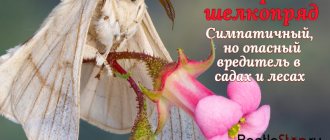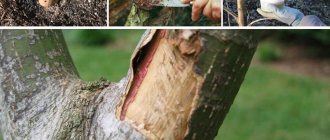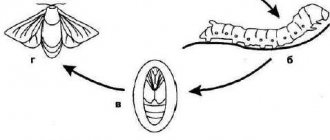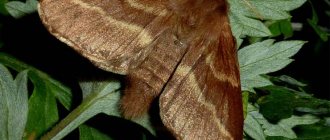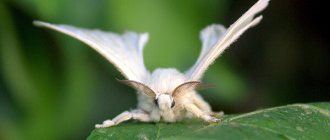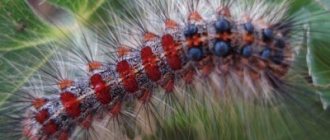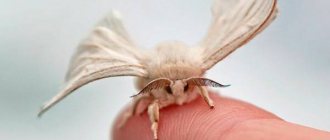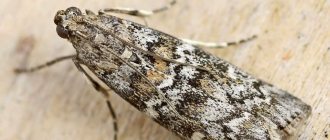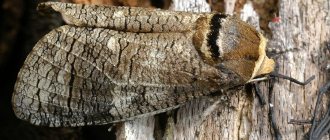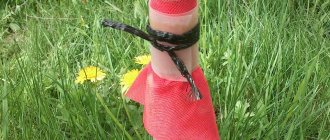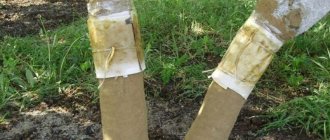Description of the insect
Larva
Gypsy moth caterpillars are hairy and have 8 pairs of legs. They reach a length of 7.5 cm. On the back there are three thin longitudinal stripes and 6 longitudinal rows of warts, from which thin long bristle-like hairs grow - aerophores. The head is matte black. The caterpillar's body is light yellow immediately after hatching; it darkens as the larva grows.
Thanks to aerophores, young caterpillars can be carried long distances by the wind. This allows them, immediately after hatching from eggs, to move long distances, populating places with an abundance of food and capturing large areas.
Adult
Male and female gypsy moths differ greatly in both shape and color. It was this feature of the insect that gave the species its name.
Females have a wingspan of 4 to 9 cm, color is white, usually with brown or gray
shade. On the first pair of wings there is a pattern in the form of four transverse zigzag stripes. There are black spots on the fringe of the front and rear wings. The antennae are black, slightly combed. At the end of the thick yellowish abdomen of the butterfly there is a pad of brown or yellow-brown hairs.
Males have a wingspan of 3 to 5 cm. The color - brown, grayish-brown or yellow - allows them to camouflage among the dry leaves lying on the ground. The front pair of wings has four transverse zigzag stripes (the same as on the female), the rear pair is lighter than the front and has a darker outer edge. There are dark brown spots on the fringe of the wings. The antennae are comb-like. The abdomen is conical, not too thick.
What does a gypsy moth look like?
The gypsy moth is a butterfly belonging to the order of Lepidoptera from the family of moths. A distinctive feature of these insects is the noticeable differences between male and female individuals.
Differences in adults are noticeable in color and shape:
- Females - the size of the wings when unfolded reaches 90 mm. The thick body has the shape of a cylinder. A grayish fluff is visible on the abdomen. The antennae are thin and long.
- Male - wingspan 40-50 mm, body thin, covered with hairs. The color of the wings is brown, the surface is covered with a pattern of dark spots and broken lines. The antennae are comb-like.
Gypsy moth butterflies prefer open forests, dry places with sufficient light. The first centers of spread are usually located on the edges. During droughts, large outbreaks of mass reproduction of silkworms occur. This species is the leader among pests in terms of the number of outbreaks of reproduction and the duration of these periods.
Reproduction
The process of reproduction and development of the gypsy plant includes several stages.
Mating and egg laying
Gypsy moth butterflies emerge from their pupae in July and August, first males, a little later - females. They fly low above the ground in the evenings, find partners and mate.
After mating, each female lays from 100 to 300 eggs on trunks, branches or tree roots protruding from the ground.
Larval development inside the egg
The eggs of the gypsy are smooth, round, slightly flattened on top. The female covers the clutch with hairs from her abdomen to give it a dark to light brown color. Most of the eggs laid overwinter above the snow cover and are exposed to low temperatures, which does not lead to their death.
Caterpillar stage
Caterpillars hatch from eggs at an average daily air temperature of 4–16 °C; usually their appearance coincides with the beginning of the growth of leaves and needles on the fodder trees.
The caterpillars actively feed for 2–2.5 months, after which they gather on trunks, branches, in the crowns of trees and shrubs and pupate.
Pupa stage
Gypsy moth pupae are dark brown or matte black in color. They are covered with sparse tufts of short brown or red hairs. The length of the pupae is from 18 to 37 mm.
Varieties of gypsy moths
Gypsy moth butterflies are classified into different species depending on their habitat and feeding habits. Among the common groups:
Pine cocoon moth
Insects are common in coniferous forests of Siberia and Europe. They damage pine plantations, less often than other species. Grayish-brown females measure 85 mm, males – 60 mm, caterpillars – up to 80 mm. Caterpillars spend the winter in the ground under tree trunks. They rise to feed in the spring and pupate in July.
Traveling silkworm
The traveling silkworm is characterized by the ability of caterpillars to migrate to new feeding areas. At the same time, they line up in a long chain, following each other. The first caterpillar, which is the leader, releases a silk thread along which the rest of the insects are guided. There are two types of traveling silkworms: oak and pine.
Siberian silkworm
The gypsy moth feeds on coniferous trees. This species damages spruce, pine, cedar and fir. The insect settled in the forest and forest-steppe zones of Siberia. The northern border of its distribution runs along the Arctic Circle. The development of a silkworm from egg to butterfly in a cold region takes 2 years. In warm years it can accelerate to an annual cycle. Siberian silkworm butterflies are distinguished by a variety of colors. Adults of brown, gray, and black colors are found. The wingspan of females is 6-10 cm, males have more modest sizes - 4-7 cm. Three dark jagged stripes run across the front wings. The hind wings are brown. The head and chest match the color of the front wings.
The clutch of butterflies is bluish in color, the size of the eggs is 2 mm. They are deposited in uneven piles of 100 pieces. They are located in the bark, on needles and twigs. When the larva appears, it eats half of the shell. The caterpillars grow up to 11 cm, their bodies are gray or black. There are blue hairs on the back. Insects are capable of taking a threatening pose. At the same time, they raise the front part of the body and bend their head. A bright yellow stripe runs along the sides. The body is covered with hairs, in the front and on the sides they are the longest.
The caterpillar's head is brown, with orange spots on its abdomen. The Siberian silkworm pupa is dark, almost black. Its length is up to 5 cm, the cocoon is suspended on branches or between needles. Stinging hairs are woven into its shell. Local silkworms are divided into three races:
- larch;
- fir;
- cedar
Silkworm caterpillars easily tolerate the cold; they go to winter at temperatures close to 00. After wintering, they crawl into trees immediately after the snow melts. As it grows, resistance to frost increases.
Information. At frosts down to -10, the caterpillars die, and they do not survive winters with little snow.
Birch
You can meet the birch silkworm in old-growth and middle-aged forests. Typically, such areas are dominated by birch trees and there is undergrowth. The insect has a light brown color and a whitish coating. On the head, back and abdomen of the silkworm you can see fluffy yellowish hairs.
This species of butterfly is found in deciduous and mixed forests, where there are many birch trees. The caterpillars feed on birch, linden, and hazel.
Mulberry
The silkworm is a real butterfly - a producer of silk threads. It practically cannot fly and often settles on a mulberry tree (mulberry). Insect larvae eat foliage in large quantities throughout the day. This creature looks rather inconspicuous and has some resemblance to an ordinary bloodworm or moth.
The caterpillar, which has pupated, begins to make a cocoon from a thin silk thread. The latter can be colored white, pink, yellow and green. In order for the silkworm to produce threads efficiently, the insect requires special conditions.
The climate in the area where this voracious creature lives should be warm with moderate humidity and a large number of plants.
Large harpy
The harpy moth is characterized by a wingspan of 5.8-7.5 cm . The large insect is painted light gray and has matte zigzag lines. There are thick white hairs on the harpy's head and chest. The distribution area of this species of silkworm can be considered throughout Europe.
The creature lives mainly in floodplain forests, along ponds and streams. In addition, it can be found in the alley of poplars. The silkworm feeds on poplar, aspen leaves and willow greens.
Nun
A butterfly from the moth family, a typical night moth. Caterpillars prefer to feed at night, making them difficult to spot in gardens. Causes significant damage by eating leaves of apple, oak, birch, and coniferous trees - pine, spruce, larch. Juniper, yew, pear, privet, currant and gooseberry are not subject to invasions of nuns. The wingspan of butterflies is up to 6 cm, the color is gray with a typical dark pattern in the form of zigzag stripes. The antennae are black, jagged.
The caterpillar is densely covered with hairs with 8 pairs of legs, 6 cm long. On the back there is a black spot in the shape of a heart, from which a dark stripe runs along the body. Red warty spots are visible on the ninth and tenth ring constrictions. Overwintering stage - eggs laid in folds of bark. The caterpillars are very voracious, producing webs on which they can be carried by the wind and cause outbreaks in large areas of forested areas. Each outbreak lasts 7-8 years, after which the number declines.
Oak
The habitat of the oak silkworm is considered to be the southern and eastern parts of Eurasia. He feels most comfortable in countries with warm climates, for example, Malaysia, India, Indonesia. Caterpillars prefer to eat oak, chestnut, and hornbeam leaves.
Herbal
A large herbaceous butterfly of the cocoon moth genus has a red-brown color. This insect is distinguished from others by the presence of white spots on the upper part of the wing. Females have larger body sizes and a thicker abdomen. Males have large, comb-like whiskers and dark colored wings. The grass silkworm can be found in the steppe and forest-steppe. This insect prefers wet biotopes, ravines, moist lowlands, near shores with active vegetation.
Nutrition
The gypsy moth butterfly has no mouthparts and does not feed at all, and the caterpillars are very voracious and polyphagous. In different habitats, gypsy is associated with different species of trees and shrubs.
The main food items for caterpillars are:
- in Europe, the Caucasus and the Far East - various types of oak;
- in the mountain forests of the Caucasus, Crimea and Carpathians - hornbeam and beech;
- in forest-steppes and small-leaved forests of Siberia - birch and aspen;
- in the mountain forests of the Urals and Sayan Mountains - various types of larches;
- in the mountains of the Altai Territory - larch, fir, pine and cedar;
- in the mountains of Central Asia - fir, spruce, pear and maple.
Caterpillars that have recently hatched from eggs feed mainly during daylight hours, while they migrate within the crown. Older caterpillars feed primarily at night, especially in persistent warm weather.
Distribution and harm
The pest has a wide distribution area. In Europe it is found up to Scandinavia, in Asia it covers many countries: Israel, Turkey, Afghanistan, Japan, China, Korea. The story of how the butterfly came to North America is interesting. The insect was introduced artificially to conduct experiments on crossing with other species. The larvae managed to spread from the experimental area into open forests. The problem that arose was not given due importance and within a few years the gypsy birds took over a huge territory. It was not until 1889 that the gypsy moth was recognized as a pest. But the insect has already firmly established itself in the new territory.
Interesting fact. Due to their wide distribution area, butterflies are divided into races. In Russia there are Far Eastern, European, Siberian and other races.
The gypsy moth caterpillar denudes deciduous trees in forests and gardens. She prefers fruit trees: apple trees, plums, and apricots. In the wild it chooses oak, birch, and linden. Avoids ash and alder. In total, the pest eats about 300 plant species, not excluding conifers. The main division occurs into the European and Asian races. The Asian group is a true polyphagous, feeding on various types of trees and bushes.
Damage caused
The gypsy moth is a typical forest pest. Gypsy grass caterpillars heavily eat the foliage of plants and cause significant damage not only to wild trees and shrubs, but also to gardens and fruit crops.
The gypsy moth is characterized by periodically occurring outbreaks of mass reproduction, during which the caterpillars settle over large areas. These outbreaks are often protracted. During the years of mass reproduction of the gypsy grass, its caterpillars can completely expose forest areas and plantings of fruit trees, eating away the foliage. This often leads to trees drying out.
Argasid mites are typical carriers of encephalitis and borreliosis pathogens. Ants are very interesting insects. See for yourself by reading our article.
"Nissoran" effectively helps in the fight against herbivorous mites. How to use this drug correctly, read the link.
Biological products
Biological preparations against silkworms
It is advisable to fight silkworms in a summer cottage where fruit trees grow using biological preparations. The active components of the products are bacteria that affect the functioning of internal organs, systems or waste products of microorganisms.
The drug begins the destructive process immediately, but the result can be seen within 7-10 days. The action lasts about 14 days. Heavy rains reduce the effectiveness of the gypsy moth remedy. It is allowed to use at any stage of the plant's growing season, except for the flowering period.
On a note!
An apple tree should be sprayed against gypsy moths for prevention once a month, for control – twice every 30 days. Effective products - Fitoverm, Lepidotsid, Iskra bio, Entobacterin, Bitoxibacilin, Dendrobatsilin.
Fighting methods
There are many ways to control gypsy moths. The optimal method is selected based on the degree of damage to plants by the pest and the stage of development of the non-greenhouse.
The main methods of combating gypsy grass include:
- collection and destruction of oviposition: in small areas of forest or in small gardens, you can manually collect (scrape) clutches of gypsy moth eggs and then destroy them;
- destruction of egg clutches using oil products: in the fall after the leaves fall or in early spring on trees with thick bark, gypsy eggs can be destroyed by covering them with oil, machine oil, kerosene;
- treatment of oviposition with insecticides;
- the use of adhesive rings: sticky rings, which are attached to the trunks, prevent the caterpillars from rising from the oviposition sites located at the roots into the tree crowns;
- manual collection and destruction of caterpillars: this method can be used by owners of small gardens; treating trees with insecticides in the spring, at the beginning of the caterpillars rising into the crown or after completion of migration.
The decline in the number of gypsy moths is also facilitated by the protection of insectivorous birds and their attraction to plantations.
In regions inhabited by the gypsy moth, its population should be carefully monitored. This helps to correctly organize planned work to curb the growth of the number of gypsum, and also allows you to predict and prevent outbreaks of its mass reproduction.
Timely adoption of measures to combat the gypsy moth will help avoid the damage that this pest can cause to plantings of fruit trees and shelter forests.
Benefits of silkworm
The silkworm not only brings harm to people, it also has significant benefits. During his existence, man has tamed and domesticated many animals. Insects are also included in this number and among them there is a silkworm. In China, about 3 thousand years ago, it was first noticed that caterpillars have a unique ability - they weave silk threads. Since then, the silkworm has been a domesticated insect that is completely dependent on humans.
The Celestial Country has been famous for the production of high-quality silk for many years. Sericulture has always been considered a profitable business. An area with a mild climate, where a mulberry tree can grow, is suitable for its organization. Its leaves are a source of food for silkworms. In Russia, sericulture began to be practiced relatively recently, but it has not become widespread.
What does it eat?
What does an insect like to eat? The name "silkworm" clearly reflects its preference - it is the foliage of the mulberry tree. Otherwise it is called mulberry. There are 17 species of this tree and all of them are suitable for feeding insects. The trees grow juicy berries of red and black color with a fragrant aroma, which become objects for eating by birds and other insects: beetles, wasps, etc. But the silkworm caterpillars are interested in foliage. The shoots and tree bark remain untouched by them.
Interesting! Silkworm larvae eat leaves continuously. Near a tree, you can even hear the characteristic sound of eating leaves, because there are a lot of caterpillars here at the same time.
In the natural environment, silkworms also eat other plants. But this is only possible if there is a lack of food. Because of this, the quality of the silk thread decreases.
Requirements for growing a butterfly from a caterpillar at home
- Several caterpillars, the brighter and thicker the caterpillars, the more beautiful your butterflies will grow.
- The caterpillar's food is the grass or leaves on which you found the caterpillar.
- A butterfly incubator is an ordinary salofan bag or a three-liter jar.
- The waiting time is usually several weeks and not more than a month.
I will tell my story of how I raised a butterfly from a caterpillar at home (I was in third grade at the time) and the play, explaining your actions.
- I found several identical caterpillars on a bush and collected a dozen. I picked up a full package of these leaves and twigs. So, when you find the caterpillars, you should do the same. If you find a caterpillar on the asphalt and want to turn it into a butterfly, then search the Internet for this caterpillar and find out what plant it eats.
- At home, I made two incubators. I put twigs with leaves in the bag, filling 40% of the bag space. I made holes in the bag with a regular nail to allow air for my pets. Everything is easy here, just repeat. Do not skimp on the number of holes, and place the holes in the middle and top parts of the bag.
- I placed 5 of my caterpillars in one house, 5 in another. And he didn’t throw them in one pile, but spread them out evenly, although I think they might crawl back to their places on their own. Then he tied the bag on top and put it in a place where it was neither dark nor light. No matter what, the sun doesn’t fall on them, but no matter what, they don’t have eternal night. Place it on a corner of a shelf, or a table, or a bedside table, decide for yourself depending on your utility capabilities.
- I constantly looked and observed, the first days they only crawled along the branches and ate leaves. The spectacle was not exciting, boring and not interesting. But we have to wait!
- After about a week there was a lull, when I looked closely I saw that there were no caterpillars! There are cocoons, how they wrapped themselves in them, I don’t even know if I missed this moment. Further, it’s even more boring to watch them, they hang stupidly and that’s it. But we wait further.
- I don’t remember how many days passed there, but I saw the chrysalises and again missed the moment when the cocoon becomes a chrysalis. There was a suspicion that this was happening at night, but in fact, I just rarely looked there. I was interested in the end result.
- One fine morning, around 11 o'clock, I woke up from a strange noise. There was something rustling in the bag. I took a closer look and saw that a yellow butterfly was fluttering there. Surprisingly, it happened. Like a savage, I put my hand in the bag and began to catch it, naturally I scratched the enamel on its wings with my fingers, gently grabbed it by the abdomen and on the balcony released it into the street and it flew away. I returned to my bags and saw a small head bursting out of the pupa into the light of day. She worked hard and for a long time to get out. Sometimes I wanted to reach out and help, but I stopped myself with the thought that I could only do harm. So don’t stop nature from doing its thing, don’t pretend to be surgeons!
- And when the butterfly crawled out before my eyes, I put my hand up and it, having just been born, was not afraid of me at all. I could pick her up and carry her, put her down and pick her up again, she only climbed, but didn’t fly. There was a thought that she was disabled and wouldn’t fly, but still, she flew up and continued to contact me without fear, allowing herself to be picked up (naturally not by the wings). This is just a miracle! I now know that she didn’t fly because her wings needed to dry.
Unfortunately, the remaining 8 caterpillars died. Nothing hatched from their pupae. Perhaps they did not have enough food supplies, perhaps the conditions were not the same or there were few holes, but most likely it was a bit dry, since they need 80-60% humidity. But in any case, out of 10 caterpillars I have, 2 butterflies were born without much care.
We invite you to read: Advantage for nursing cats
Well, in conclusion, I’ll tell you that you can make money from butterflies (I wrote about this in the article Fear of Retirement), but growing a butterfly at home is not difficult and you don’t need any investment.
Habitat
For most species of caterpillars, the habitat is the surface of the earth, some species live in water, for example, the caterpillars of broad-winged moths, and the larvae of the Hawaiian moth can exist both in the air and under water.
According to the conditions of existence, these insect larvae are divided into two categories - hiding and leading a lifestyle in plain sight.
The hidden ones are represented by:
- leafworms - these caterpillars live on trees, existing in twisted leaves;
- frugivores - live in fruits and vegetables;
- by drillers - the habitat of tree trunks and roots;
- miners - the habitat is foliage, branches, fruit and vegetable peels, plant buds - caterpillars make passages;
- gall formers - they cause damage to plant tissues and the appearance of new growths on them;
- living underground;
- aquatic – the habitat is bodies of water.
Leading a free lifestyle, they openly exist on plants; these are mainly caterpillars of large varieties of butterflies.
Questions
Natalya, 27 (Ivanovo): Why does silk require careful washing? Silk thread is actually an air-hardened secreted protein that is treated with sericin by the insect. Such natural components can be destroyed by vigorous washing and the use of alkaline detergents. Hand washable at water temperatures up to 30 degrees. Otherwise, the silk will lose its elasticity. It is necessary to exclude solutions of alkaline salts (soda, potash, etc.). Even laundry soap contains free alkali, which leads to fabric damage.
Marina, 34 (Arkhangelsk): How are silkworm cocoons used for cosmetic purposes?
We are talking about cosmetic care applications. Whole cocoons are soaked and put on the fingers. Then they massage the face, bypassing the skin around the eyes. This is how a soft scrubbing effect turns out. The naturalness of this care product allows it to be used even by a child in adolescence. There is often an age limit of 14+.
